Spatial Patterns of Urban Innovation and Their Evolution from Perspectives of Capacity and Structure: Taking Shenzhen as an Example
Abstract
:1. Introduction
2. Data Description and Processing
2.1. Description of Data for Innovation Evaluation
2.2. Spatialization of Patent Data
3. Method
3.1. Innovation Capacity Index of a Spatial Unit
3.2. Innovation Structure Index of a Spatial Unit
3.3. Spatial Autocorrelation Analysis
3.4. Analysis of Spatial Distribution Characteristics
4. Spatial Pattern of the Innovation Capacity and Its Evolution
4.1. Agglomeration Pattern of the Innovation Capacity and Its Evolution
4.2. Evolution of the Innovation Capacities of Different Areas
4.3. Spatial Distribution Pattern of the Innovation Capacity
5. Spatial Pattern of the Innovation Structure and Its Evolution
5.1. Evolution of the Innovation Structures of Different Areas
5.2. Spatial Distribution Pattern of the Innovation Structure
6. Conclusions and Discussion
Author Contributions
Funding
Acknowledgments
Conflicts of Interest
References
- Li, G.; Wei, W. Financial development, openness, innovation, carbon emissions, and economic growth in China. Energy Econ. 2021, 97, 105194. [Google Scholar] [CrossRef]
- Goetz, S.J.; Han, Y. Latent innovation in local economies. Res. Policy 2020, 49, 103909. [Google Scholar] [CrossRef]
- Wang, J.; Liu, N.; Ruan, Y. Influence Factors of Spatial Distribution of Urban Innovation Activities Based on Ensemble Learning: A Case Study in Hangzhou, China. Sustainability 2020, 12, 1016. [Google Scholar] [CrossRef] [Green Version]
- Tang, S.; Zhang, J.; Niu, F. Spatial-Temporal Evolution Characteristics and Countermeasures of Urban Innovation Space Distribution: An Empirical Study Based on Data of Nanjing High-Tech Enterprises. Complexity 2020, 2, 2905482. [Google Scholar] [CrossRef]
- Wang, C.; Lin, G. The growth and spatial distribution of China’s ICT industry: New geography of clustering and innovation. Issues Stud. 2008, 44, 145–192. [Google Scholar]
- Zhou, R.; Zhang, Y.; Gao, X. The Spatial Interaction Effect of Environmental Regulation on Urban Innovation Capacity: Empirical Evidence from China. Int. J. Environ. Res. Public Health 2021, 18, 4470. [Google Scholar] [CrossRef] [PubMed]
- Neulndtner, M. An Empirical Agent-Based Model for Regional Knowledge Creation in Europe. Int. J. Geo-Inf. 2020, 9, 477. [Google Scholar] [CrossRef]
- Li, T.; Fu, W. Spatial processes of regional innovation in Guangdong Province, China: Empirical evidence using a spatial panel data model. Asian J. Technol. Innov. 2016, 23, 304–320. [Google Scholar] [CrossRef]
- Crescenzi, R.; Rodríguez-Pose, A.; Storper, M. The territorial dynamics of innovation: A Europe-United States comparative analysis. J. Econ. Geogr. 2007, 7, 673–709. [Google Scholar] [CrossRef]
- Usai, S.; Moreno, R.; Paci, R. Spatial spillovers and innovation activity in European regions. Soc. Sci. Electron. Publ. 2005, 37, 1793–1812. [Google Scholar]
- Wang, Y.; Wang, C.; Mao, X.; Liu, B.; Zhang, Z.; Jiang, S. Spatial Pattern and Benefit Allocation in Regional Collaborative Innovation of the Yangtze River Delta, China. Chin. Geogr. Sci. 2021, 31, 900–914. [Google Scholar] [CrossRef]
- Ceh, B. Regional innovation potential in the United States: Evidence of spatial transformation. Pap. Reg. Sci. 2001, 80, 297–316. [Google Scholar] [CrossRef]
- Paci, R.; Usai, S. Externalities, Knowledge Spillovers And The Spatial Distribution Of Innovation. GeoJournal 1999, 49, 381–390. [Google Scholar] [CrossRef]
- Gonçalves, E.; Almeida, E. Innovation and spatial knowledge spillovers: Evidence from Brazilian patent data. Reg. Stud. 2009, 43, 513–528. [Google Scholar] [CrossRef]
- Xu, W.X.; Liu, C. The Spatial Pattern and Driving Force of Innovation of Industrial Cluster and County Urbanization Coupled Coordination in Zhejiang Province. Sci. Geogr. Sin. 2015, 29, 1597–1605. [Google Scholar]
- Li, L.; Zhang, X. Spatial evolution and critical factors of urban innovation: Evidence from Shanghai, China. Sustainability 2020, 12, 938. [Google Scholar] [CrossRef] [Green Version]
- Duan, D.; Du, D.B.; Liu, C.L. Spatial-temporal evolution mode of urban innovation spatial structure:A case study of Shanghai and Beijing. Acta Geogr. Sin. 2015, 70, 1911–1925. [Google Scholar]
- Vasta, M.; Nuvolari, A. The geography of innovation in Italy, 1861-1913: Evidence from patents data. Eur. Rev. Econ. Hist. 2017, 21, 326–356. [Google Scholar]
- Kryukov, V.A.; Tokarev, A. Spatial trends of innovation in the Russian oil and gas sector: What does patent activity in Siberia and the Arctic reflect? Reg. Sci. Policy Pract. 2021, 6, 1–20. [Google Scholar] [CrossRef]
- Bai, Y.; Chou, L.C.; Zhang, W.H. Industrial innovation characteristics and spatial differentiation of smart grid technology in China based on patent mining. J. Energy Storage 2021, 43, 103289. [Google Scholar] [CrossRef]
- Acs, Z.J.; Audretsch, D.B. Patents as a Measure of Innovative Activity. Kyklos 1989, 42, 171–180. [Google Scholar] [CrossRef]
- Cheng, C.Y.; Kung, L.C. Evaluation of innovation risk through patent risk factors: An empirical approach. Queen Mary J. Intellect. Prop. 2019, 9, 414–429. [Google Scholar] [CrossRef]
- Klein, M.A. Secrecy, the Patent Puzzle and Endogenous Growth. Eur. Econ. Rev. 2020, 126, 103445. [Google Scholar] [CrossRef]
- Li, W.; Wang, J.; Chen, R.; Xi, Y.; Liu, S.Q.; Wu, F.; Masoud, M.; Wu, X. Innovation-driven industrial green development: The moderating role of regional factors. J. Clean. Prod. 2019, 222, 344–354. [Google Scholar] [CrossRef]
- Castellacci, F.; Natera, J.M. The dynamics of national innovation systems: A panel cointegration analysis of the coevolution between innovative capability and absorptive capacity. Res. Policy 2013, 42, 579–594. [Google Scholar] [CrossRef] [Green Version]
- Wei, G.J.; Economics, S.O.; University, F.N. Study on the knowledge generation of industries in innovation and route switch in China (in Chinese). Stud. Sci. Sci. 2018, 36, 1036–1047. [Google Scholar]
- Wang, J.; Sun, Y.T.; Liu, F.C. Study on the Double Main Carriers Position of Chinese Enterprises’ Technological Innovation. China Soft Sci. 2012, 9, 146–153. [Google Scholar]
- Hong, J.; Zheng, R.; Deng, H.; Zhou, Y. Green supply chain collaborative innovation, absorptive capacity and innovation performance: Evidence from China. J. Clean. Prod. 2019, 241, 118377.1–118377.13. [Google Scholar] [CrossRef]
- Zhang, K.; Qian, Q.; Feng, Z. Distribution Patterns and Multilevel Factors of the Innovation Activities of China’s New Energy Vehicle Industry. ISPRS Int. J. Geo-Inf. 2021, 10, 385. [Google Scholar] [CrossRef]
- Wang, M. Research on the Sustainable Synergetic Development of Chinese Urban Economies in the Context of a Study of Industrial Agglomeration. Sustainability 2020, 12, 1122. [Google Scholar] [CrossRef] [Green Version]
- Goldstein, G.S.; Gronberg, T.J. Economies of scope and economies of agglomeration. J. Urban Econ. 1984, 16, 91–104. [Google Scholar] [CrossRef]
- Tauchen, H.; Witte, A.D. An Equilibrium Model of Office Location and Contact Patterns. Environ. Plan. A 1983, 15, 1311–1326. [Google Scholar] [CrossRef]
- Van Groenigen, J.W.; Stein, A.; Zuurbier, R. Optimization of environmental sampling using interactive GIS. Soil Technol. 1997, 10, 83–97. [Google Scholar] [CrossRef]
- Li, X.; Gao, B.; Bai, Z.; Pan, Y.; Gao, Y. An Improved Parallelized Multi-Objective Optimization Method for Complex Geographical Spatial Sampling: AMOSA-II. Int. J. Geo-Inf. 2020, 9, 236. [Google Scholar] [CrossRef]
- Yang, S.Z.; Mao, Z.P.; Liu, C.; Wang, S.Y.; Cheng, D.S.; Wang, L.; Wu, J.P.; Du, Y.L. An aquatic ecoregion delineation approach based on GIS and spatial environmental data in Heihe River Basin, Northwestern China. Quat. Int. 2015, 380, 272–281. [Google Scholar]
- Cornelis, J.; Hermy, M. Biodiversity relationships in urban and suburban parks in Flanders. Landsc. Urban Plan. 2004, 69, 385–401. [Google Scholar] [CrossRef]
- Zhu, Y.; Wang, Z.; Qiu, S.; Zhu, L. Effects of Environmental Regulations on Technological Innovation Efficiency in China’s Industrial Enterprises: A Spatial Analysis. Sustainability 2019, 11, 2186. [Google Scholar] [CrossRef] [Green Version]
- Li, B.; Wu, S. Effects of local and civil environmental regulation on green total factor productivity in China: A spatial Durbin econometric analysis. J. Clean. Prod. 2016, 153, 342–353. [Google Scholar] [CrossRef]
- Fischer, M.M.; Getis, A. Handbook of Applied Spatial Analysis: Software Tools, Methods and Applications; Taylor & Francis, Inc.: Abingdon, UK, 2011. [Google Scholar]
- Wong, D.W.S. Several fundamentals in implementing spatial statistics in GIS: Using centrographic measures as examples. Geogr. Inf. Sci. 1999, 2, 163–173. [Google Scholar]
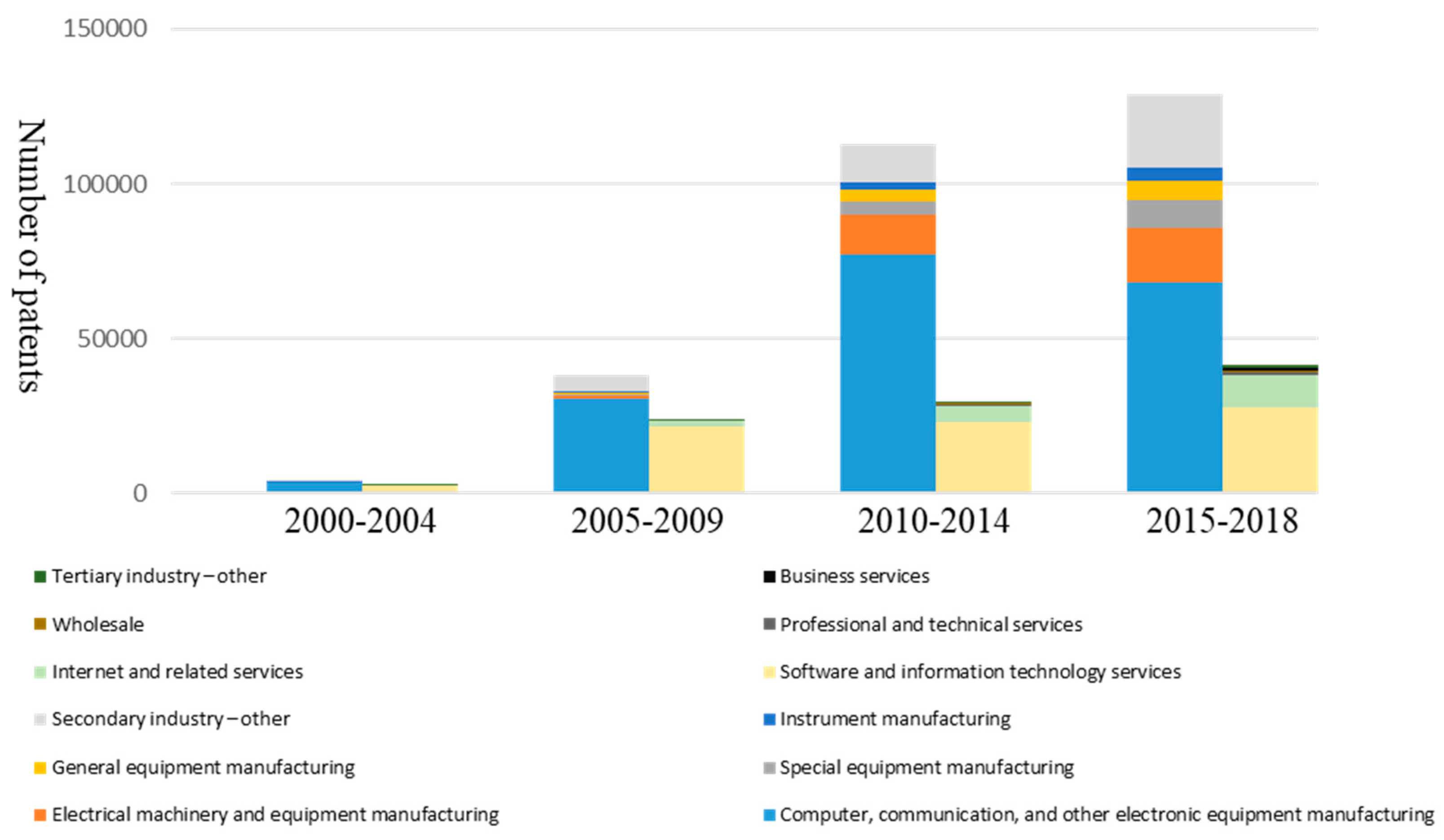
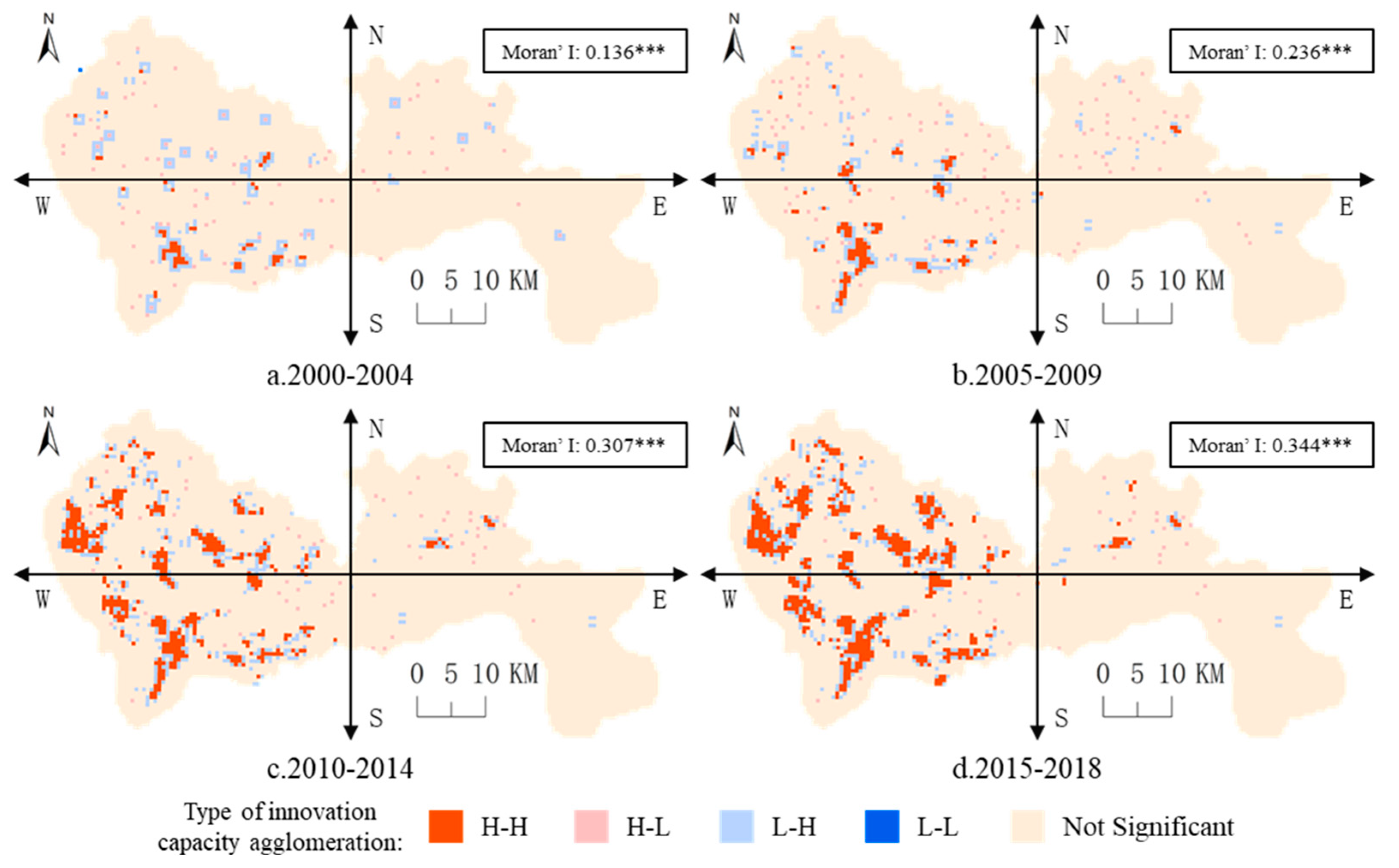

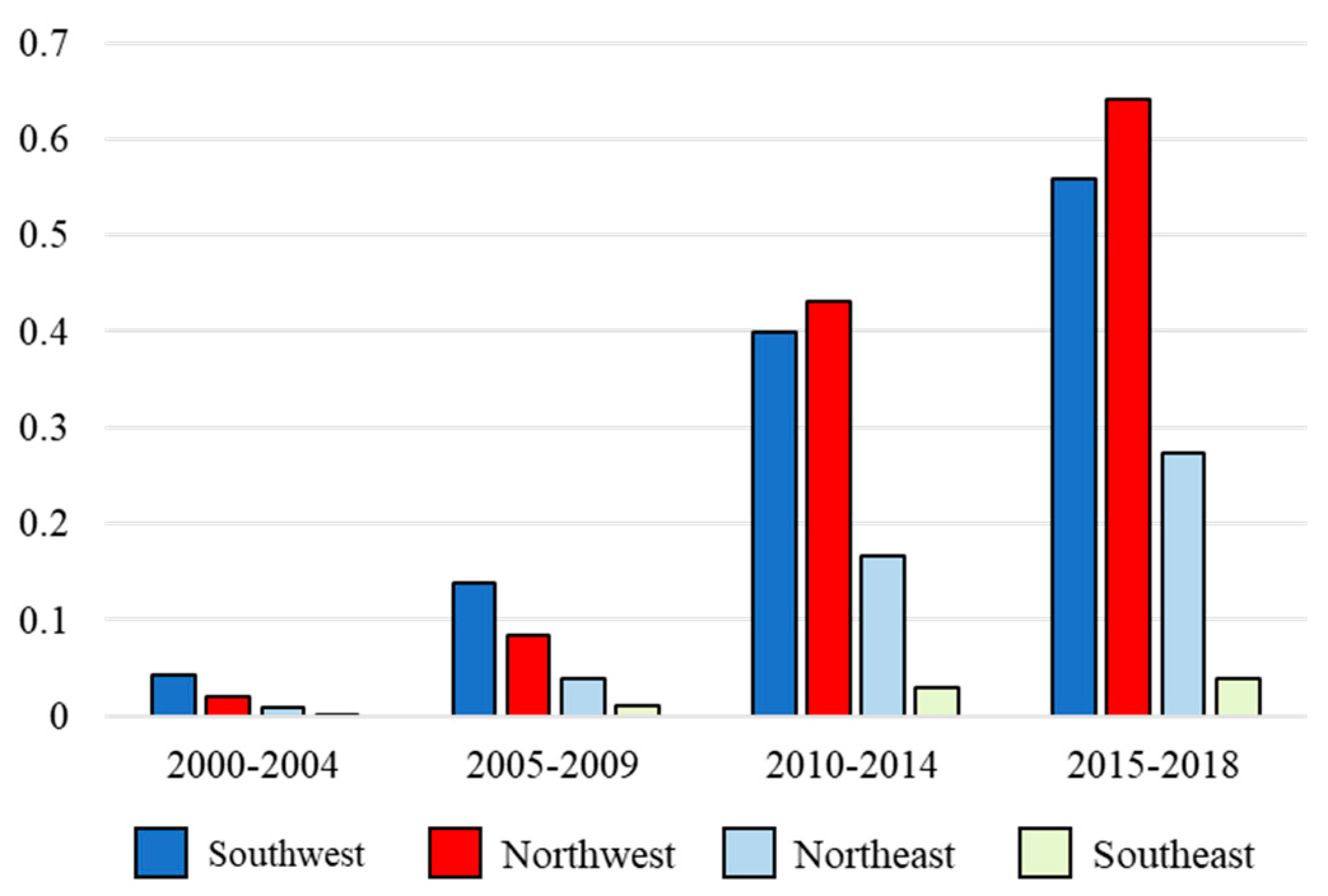



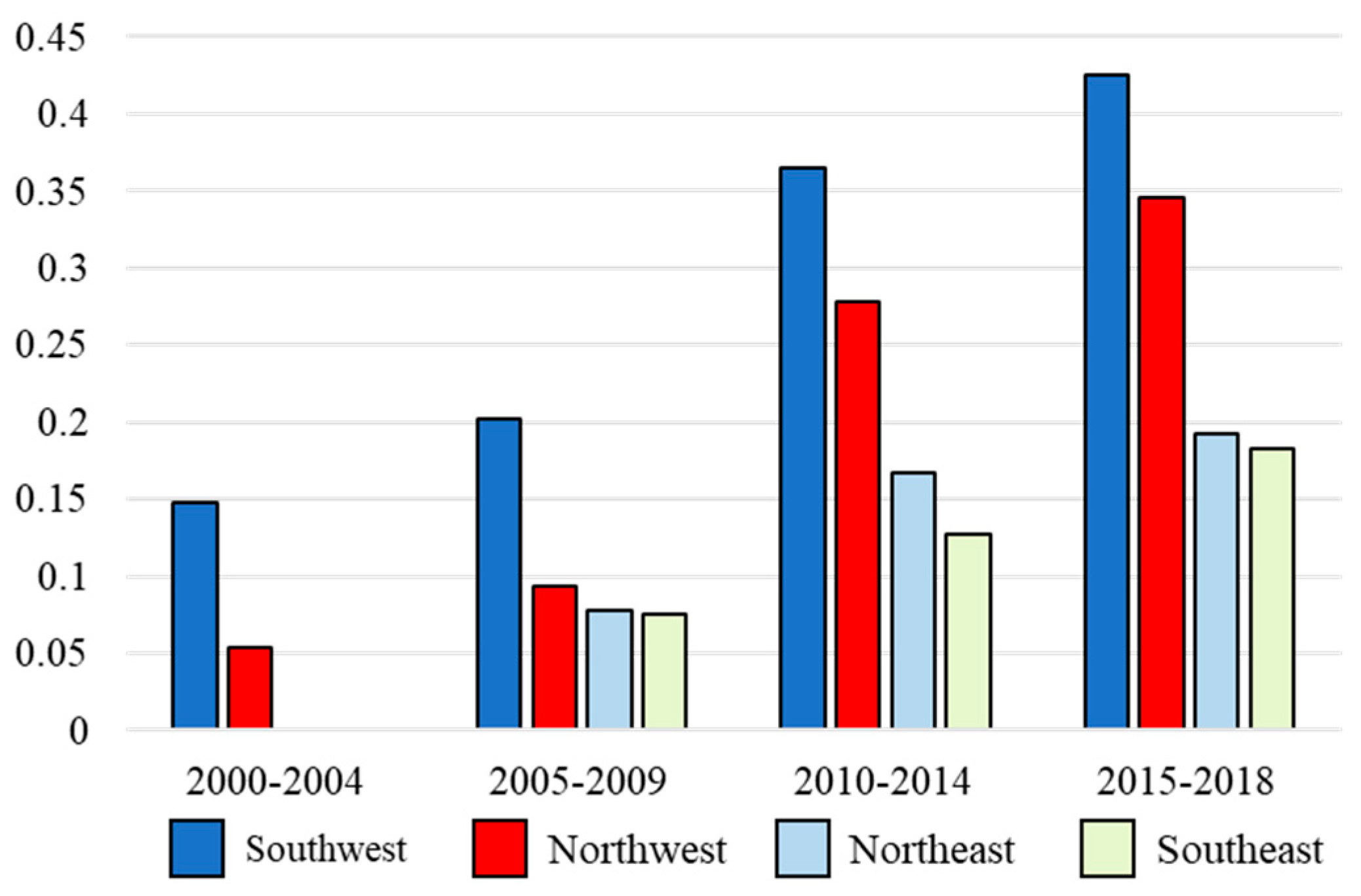
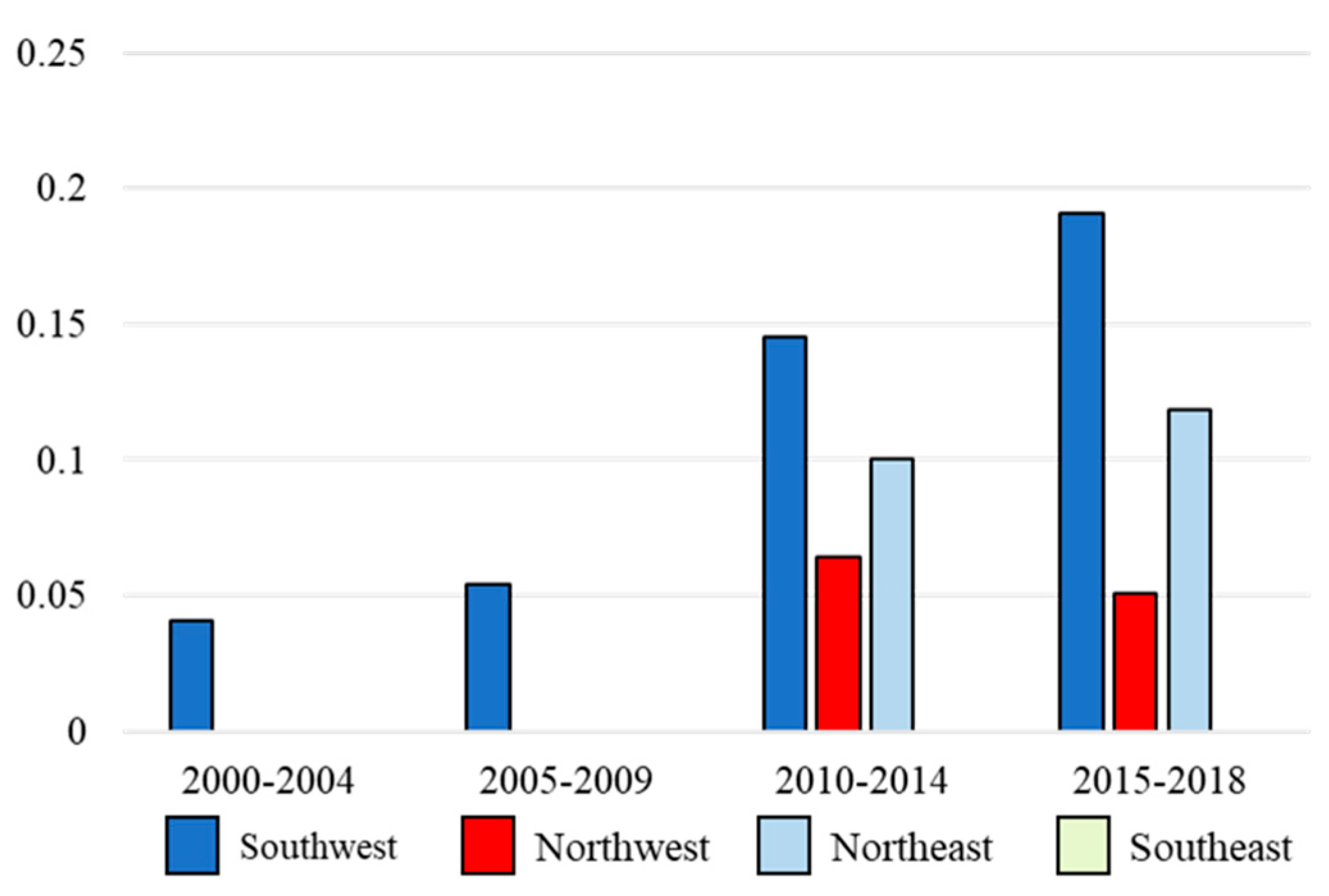

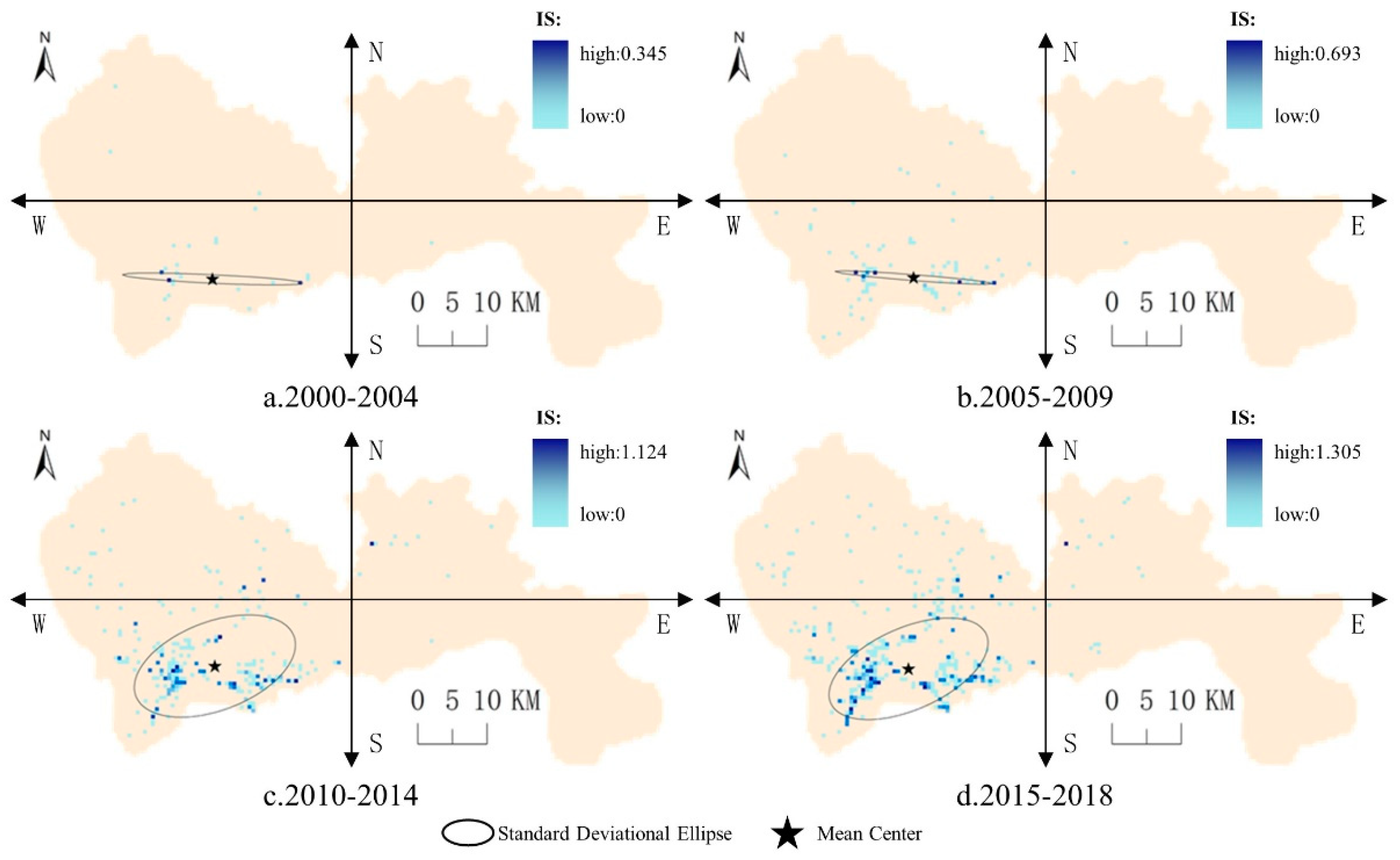
Publisher’s Note: MDPI stays neutral with regard to jurisdictional claims in published maps and institutional affiliations. |
© 2021 by the authors. Licensee MDPI, Basel, Switzerland. This article is an open access article distributed under the terms and conditions of the Creative Commons Attribution (CC BY) license (https://creativecommons.org/licenses/by/4.0/).
Share and Cite
Hu, E.; Hu, D.; He, H. Spatial Patterns of Urban Innovation and Their Evolution from Perspectives of Capacity and Structure: Taking Shenzhen as an Example. ISPRS Int. J. Geo-Inf. 2022, 11, 7. https://doi.org/10.3390/ijgi11010007
Hu E, Hu D, He H. Spatial Patterns of Urban Innovation and Their Evolution from Perspectives of Capacity and Structure: Taking Shenzhen as an Example. ISPRS International Journal of Geo-Information. 2022; 11(1):7. https://doi.org/10.3390/ijgi11010007
Chicago/Turabian StyleHu, Erjie, Di Hu, and Handong He. 2022. "Spatial Patterns of Urban Innovation and Their Evolution from Perspectives of Capacity and Structure: Taking Shenzhen as an Example" ISPRS International Journal of Geo-Information 11, no. 1: 7. https://doi.org/10.3390/ijgi11010007





